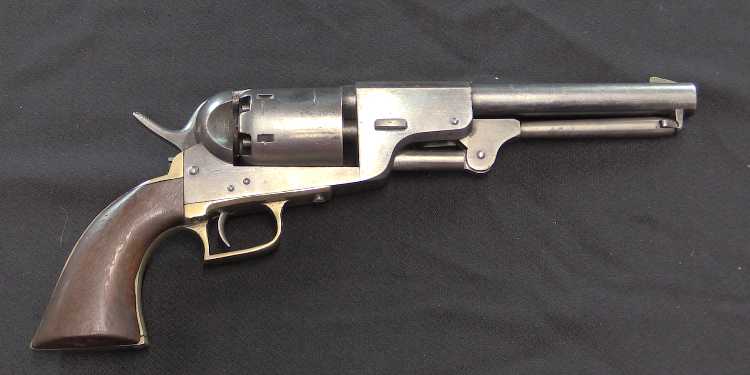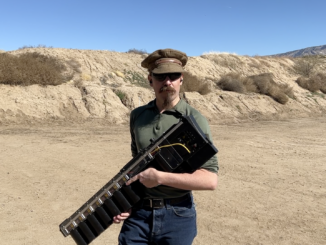The Halloway Arms Company HAC-7 was a very interesting hybrid design that incorporated elements of the FAL, AR10, and AK designs. It needed a bit more development to really work out the kinks, though, and only 300 were made (including a couple carbines and some mirrored left-handed examples) before the company went bankrupt. The guns today are rare and expensive, but I had a chance to take one out to the range back in 2013. I think the gun is really interesting, and most of the folks watching today did not see this video when it came out. So it’s a great candidate for Throwback Thursday…
Related Articles

Aircraft MGs
Richard Wray Machine Gun Auction Followup
So, the auction of the late Richard Wray’s machine gun collection (see previous post) was yesterday, with the non-NFA guns being auctioned today. The final prices are interesting to look at, with some wallet-wrenchingly high […]

Handgun
James D. Julia: Tucker & Sherrard Texas Confederate Revolver
The Tucker & Sherrard (and later Sherrard & Clark) is one of the more interesting Texas Confederate revolvers. The company initially was granted a contract with the Texas state government to provide 100 revolvers per […]

Competition
I Tried to Use the GR-1 Anvil at the BUG Match…
So, I took the GR-1 to this month’s Backup Gun Match…but all did not go as I’d hoped. We blew a fuse in the gun (it is still an alpha prototype, remember), and were not […]

Damn, makes me want to go out and find a copy of Soldier of Fortune. You know you are getting old when guns you remember as new and cool end up on Forgotten Weapons. . . and they really are all but forgotten.
[OFF-TOPIC SO IGNORE IF YOU WISH]
Some time ago post was published by Veteran News UK see screenshot
https://mpopenker.livejournal.com/2662589.html
which say new SLR-A2 rifle is to return to service for British Army Troops
Is this some kind of joke beyond my comprehension or it is serious and it will be done?
I think it is indeed someone’s attempt at humor and it is pretty funny at that. The tip off would be the quote saying something about a mans gun being back in the army.
You mention failures to feed.
ARs manage to sweep a locking lug through both sides of the feed opening in the mag.
The first Mauser bolt action to have a double stack, double feed magazine (the 1893) had a square extension on the bottom of the bolt face.
An AK has a big extension on the bolt to sweep through the mag.
I’m not saying that that bottom lug being relatively narrow and running down the centre of an AR mag, is the reason for some of the feed problems with the HAC 7, but it’s worth considering.
There’s also another reason for the locking lugs on a Mauser travelling horizontally and locking vertically…
It puts a locking abutment in the feed path, helping to lift a feeding round into the chamber, rather than hitting the bottom or the side of the breech face of the barrel.
Interestingly, the Mosin-Nagant, with its vertical travelling lugs, also has a filler piece to prevent the back of the bottom lug, from catching on the next round.
A mosin-Nagant also has a single stack magazine and a magazine interrupter…
I did not notice “failures to feed” but saw an auto sear error and misfire.
I think this is more likely due to insufficient constructive study and insufficient locksmith debugging.
This is also indicated by the bolt carrier, which was stuck during disassembly.
Besides.
Overall, it is not surprising that this rifle “did not fly”.
You cannot copy the AK bolt without helically adjusting the bolt bearing surfaces.
This rifle will have to be individually configured for each manufacturer’s ammunition.
I have said this before, and being the age that I am I am sure I will say it again, but I thought I had watched every episode of FW. I started a good few years ago, and I thought I went and watched from them all from start, the first time I was proper ill; butl this video was new, so I obviously cannot be trusted to remember bugger all, which is worth remembering at my age..
Did any of this unique design get thought about in the WWSD?
So as a possible investor, I would have wanted to know, “Who is the intended customer” and “What is your break0even point”
Precisely – this is a key consideration, before one finds himself engulfed by “gun enthusiasm”. Who/ where is the market and what is the necessary profit margin to make living. For how much I can sell and how much of customer base to expect.
When we look, as an example at Robinson’s Arms outfit, we see how the poor guy struggles and struggles… and struggles, without impression of overwhelming success. His XCR rifle is good, no doubt, but so is the PRICE.
Another example: Kel-tec. Their gun division is a part of business (industries) which includes tool and machine-building. Not a bad approach. Here is “the bread and butter” and fiddling with favored subject on the side. Smart guy that Mr. Kellgren is. Similar kind was the Para Ordnance at very beginning in Ontario; they started with injection mold building.
“So as a possible investor,(…)“Who is the intended customer”(…)”
Hmm… maybe customers which would want rifle with label PROUDLY DESIGNED IN U.S.A and therefore unwilling to use FAL?
An amazing blending of different technologies.
It’s the platypus of rifles.
I am not sure if combining all those known designs secures a success. Likely not. Every time you conceptualize a locking system you start off deciding how many lugs you need to do a particular task (e.g. locking, stripping, carrying extractor etc.). From that comes requirement how many degrees of turn are need.
From my long time observation, the three Lugs are optimal (this does not mean you need 60 degree turn). What you see on AR is not exactly the best, because it leads to tiny “barbs” merely 2.5mm (0.102″) wide which requires high mfg. accuracy and high quality material (tool steel!) not to mention heat treatment; an expensive proposition with high scrap rate.
Reducing lugs to only TWO poses a necessity of long Bolt “over-hang” when unlocked. This is not conducive to reliability (aka snubbing following round in magazine during return). It can be done, as the FNC proves it, but it needs attention to details. Comparing it with manually operated rifles does not fit because the manual operation is lot slower and magazine spring has time to react. The added fill as shown n this design is not exactly the best solution, nota bene is is NOT needed if all is done correctly.
If you look at AK Bolt, you see it needs only 45 degree rotation which results in Bolt’s short overhang. MAINLY however, it is the fact there is a dedicated STRIPPING lug with heavy back taper. This prevents snagging and facilitates trouble free function. SIG people knew perfectly well why they chose this design as a master.
Closer you look at HAC-7 you realize, it is less than “nifty”. Let’s look at the odd gas operating system; not an optimal to be sure.
The combination of gas pipe and back-set piston does not seem to display a clear merit. In contrary, what we see on Ljungman AG42 or MAS 49/56 is a gas conduit all the way to breech face – and that makes sense providing the the combustion residue does not create a problem in long run.
The gas tube section could have been substituted for by “gas tappet” which we have seen in so many applications – for instance at HK G36. True – it does make the action mass volume and location more favorable – without being finicky. It is fool proof at this time.
So, NOT quite without interest, but a confused attempt without signs of deeper previous knowledge of similar thoughts. If you care for it, your predecessors/ competitors have done good part of work for you!
What a shame – world is “poorer” by one more unsuccessful “battle rifle” attempt. Good show and thanks to Ian anyway. We can imagine it is harder and harder to find new subjects; it is a tough job he took on himself. But he is doing it – par excellence.
Question that occurred to me, watching this: Has anyone, ever, tried doing a true controlled-feed semi-auto/automatic rifle as an individual weapon? It seems as though such a thing would make for much higher reliability, yet I’ve never seen such a design actually implemented.
Push feed vs controlled feed
there is no practical difference.
Provided, of course, that everything is designed and manufactured correctly.
In the image under consideration, the main problem is the lack of strength and rigidity of the upper receiver for such a powerful ammunition.
Therefore, the cam pin pocket cover falls off and the bolt carrier gets stuck.
Putting on a gas tube is not a bad idea. This is necessary for a later start of the movement of the bolt carrier. Otherwise, the automatics will work very finicky from different ammunition.